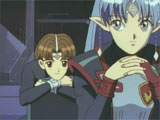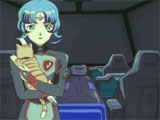

Quick Links:
Banner of the Stars, Volume 1: No Turning Back
Seikai no Senki (Banner of the Stars) began as a series of novels penned by mastermind Hiroyuki Morioka. Crest of the Stars is the first in this series, creating a unique relationship between a space faring Abh princess and a land-dwelling commoner-turned-noble. The anime Crest of the Stars portrayed this relationship with elegance, punctuated by the exciting action that Sunrise studio is famous for. Vastly different from the Gundams and Gasarakis, Banner has formed its own niche in the Sunrise conglomerate as an intellectual and sophisticated window into the art of war tactics. Banner also manages to capture a down to Earth and personal look at human relationships that is easy to relate to and perhaps even touching.
Banner of the Stars does not have much of a beginning, per se. It is a continuation of the story set in motion by Crest of the Stars, beginning right where the final scene of Crest left off. After the Humankind Empire Abh declared war against the United Mankind, a massive conflict took place that has all but exhausted the military resources of both sides. Because of this, both sides have agreed to a cease fire. The United Mankind forces did succeed in cutting two sides of the Abh empire off from each other, though. Now, three years after the beginning of the war, the Abh plan to cast the United Mankind out of their territory and reunite with their allies on the other side. This campaign is known as Operation Phantom Flame.
Jinto and Lafiel now serve in the imperial star forces on Lafiel's attack ship, the Basroil. Jinto serves as a supply officer, and his office as Count of the Hyde system is on the ship as well. His entire territory consists of his living quarters on the Basroil, due to the fact that the Hyde system is currently held by the United Mankind. As the story opens, the Basroil and her crew are preparing for the upcoming operation through war exercises. The crew are aware of the friendship between Jinto and Lafiel, but show no ill will toward the two. The fact that they are all Abh (at least by manner) means that they act professionally and are focused on their duties. They are even amused by Jinto's general cluelessness, and they all get along rather well.
The fact that a member of royalty and a noble both serve aboard the Basroil make it a special ship. It also has one non-humanoid resident: Jinto's feline companion, Diaho. When Jinto and Lafiel converse (usually as a result of the cat getting in her room), it's easy to forget that they are on a military vessel. She has become more open toward him, and he has picked up a small amount of wisdom, it seems.
As to the story of volume 1, there's surprisingly little to tell. There is quite a bit of dialogue between Jinto and Lafiel to show how each has matured in the three years they've been apart. We are also introduced to the crewmembers occupying the Basroil's bridge, two of which are Abh by birth, and a "Lander," the term used to signify a person who was born on a planet. The colorful Admiral Spoor makes a reappearance as the commander of the attack force for Operation Phaontom Flame. The interesting development of this volume is that Lafiel's commanding officer is the younger sister of the Baron of the Febdash territory, with whom Jinto and Lafiel had a skirmish in the Crest series. Aside from all the dialogue, which never fails to spark interest, exciting space battles continue to grace the series. The volume ends with one such battle, which is Lafiel's first as captain of a ship. To put it simply, expect the same experience that Crest of the Stars offered.
The animation for the Banner series carries along the same high quality as its predecessor, and the transfer does nothing to spoil it. Audio and video are both clean and sharp. My only quibble is with a problem that was apparent in the Crest series as well. When the Abh language is spoken in the show (usually at the beginning of an episode), a Japanese translation appears on screen, and the English subtitles appear over it. The yellow English subs are difficult to read over the white Japanese subs. There is no problem with subtitles at any other point in the show, and the writing appears to have improved over the last show. Musically, Banner offers little new over Crest. There is a remixed version of the main theme and a new ending theme, but very little has changed in this area. The music still does little to make a name for itself, but blends with the show well and is an indispensible part of the show's atmosphere, especially where battles are concerned.
The packaging for Volume 1 shows a good number of important characters from the series, capturing their personalities pretty well too. The insert for the DVD contains a short write-up titled "The State of the Empire," which briefly explains the purpose of Phantom Flame. Disc extras include trailers for other Bandai shows, a story synopsis of Crest of the Stars (presumably for those who chose to go with Banner as their first exposure to the story, a move I wouldn't recommend), and commentary by creator Hiroyuki Morioka, titled "Newsletter of the Stars." The "newsletter" I would say is the best extra, since it gives a bit of information on what went into the show's production.
In a way, this first volume of Banner was nothing new. It is consistent with the excellent atmosphere and character development we were spoiled with in Crest of the Stars. Certainly, one who liked Crest should take this series for a spin. The continued exposition of Jinto and Lafiel's relationship over the backdrop of a massive interstellar war is compelling enough for this simple reviewer to keep watching.
Distributor: Bandai Entertainment Creator: Sunrise Released: 2001
Video Quality: A+ Audio Quality: A Presentation: A+ Content: A Overall: A



